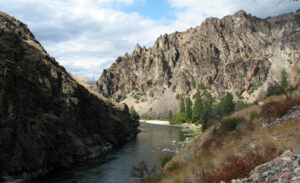As we speak, Congress is working to pass the National Defense Authorization Act. And, just like before, certain members of Congress are trying to tack on controversial provisions to this must-pass legislation. This time, it’s the dirty permitting “side deal” Senator Joe Manchin demanded as part of the recently passed Inflation Reduction Act.
If passed, the side deal would gut some of the nation’s bedrock environmental and cultural protection laws–laws that communities rely on to protect themselves from irresponsible mining. Considering that hardrock mining is already the nation’s number one toxic polluter and has been for as long as anyone has kept track, to call this alarming would be a major understatement. We are doing everything we can to stop it (and you can too).
The mining industry and its allies in Congress like to claim that it takes too long to permit a mine, and we have to streamline the process. But that claim doesn’t hold up under scrutiny. According to the Government Accountability Office, one of the primary reasons for delays in mine permitting are that the mining companies’ plans were poorly thought out or missing critical information. Another big factor was that the permitting agencies–the Forest Service and the Bureau of Land Management–were operating on a shoestring budget after years of cuts.
Would streamlining permitting address either of these problems? Clearly not. To illustrate, let’s look at an example from the Payette National Forest in Idaho, where the proposed open-pit Stibnite Gold Project has encountered a series of major delays in the permitting process.
Problem #1: Failing to deliver adequate and timely information. Perpetua Resources (formerly Midas Gold) turned in a plan of operations in September 2016, but it was missing key components. The Forest Service requested the missing info, which caused multiple months-long delays.
Problem #2: Changing the mine plan mid-stream. Repeatedly. The most significant overhaul came after the Draft Environmental Impact Statement public comment period closed. Midas Gold made major changes to nearly every facet of the proposed mine, including the transportation route, transmission lines, waste management and disposal, water management, processing facilities, and reclamation and closure. This tinkering has bogged the environmental review process down in a sea of red tape, resulting in years of delays.
To be clear, the National Environmental Protection Act is designed to be flexible. It uses the environmental review process to consider public comments and revise the plan to minimize and mitigate impacts. However, the Stibnite project’s backers rushed a series of unfinished proposals out for public review and then unfairly blamed the Forest Service and the NEPA process for the subsequent delays in the project timeline.
You can read our full case study on the Stibnite project’s permitting foibles here. Manchin’s industry-friendly permitting side deal would bake-in all the mistakes of such a poor plan, saddling the Nez Perce (the mine site is completely within their traditional lands) and downstream communities with whatever water pollution and other impacts result from the project.
Senator Schumer and the White House must take a hard stand against the exploitation of frontline communities, reform our mining policies, and end fossil fuel subsidies.
This article was updated from the original, published on September 26th. Since then, thanks to a massive nationwide movement, the permitting side deal was defeated. On December 5, we learned that the same text has reemerged, proposed to be attached to the National Defense Authorization Act. Please tell your representative to stop the latest version of the permitting Dirty Deal.


